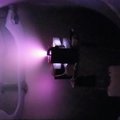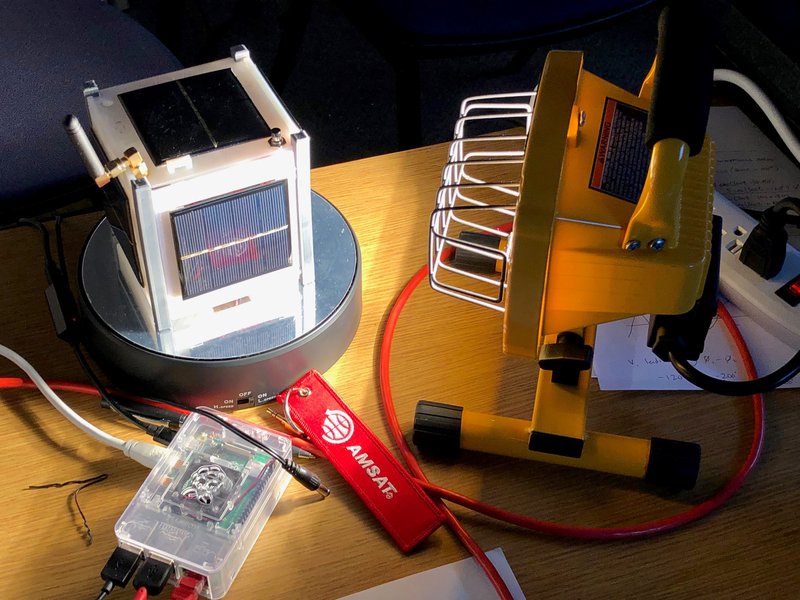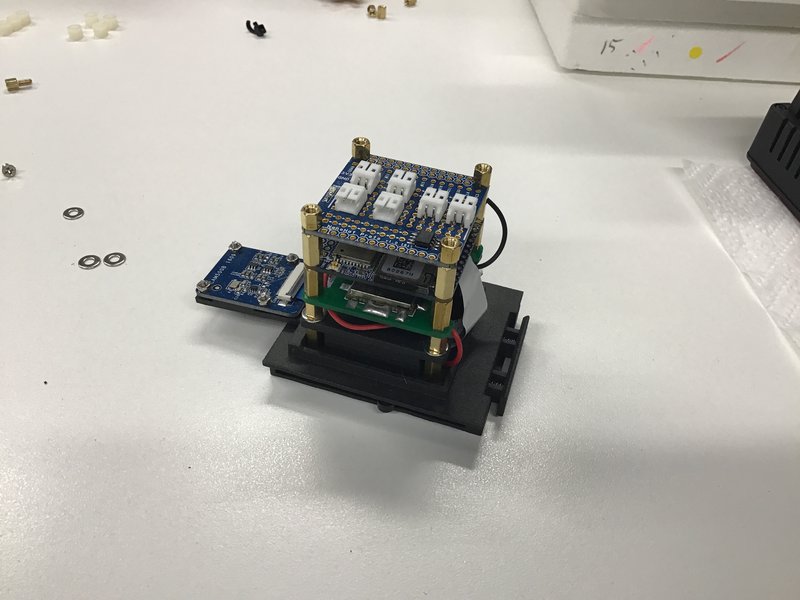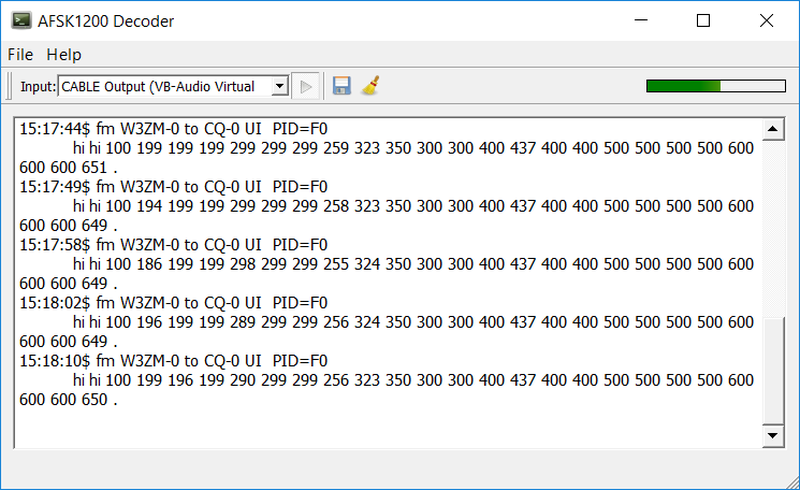Hi everyone!
 Hi Alan
Hi Alan
 You guys don't have audio?
You guys don't have audio?
:o)
 Hi @alan.b.johnston! We'll kick off in just a minute or two
Hi @alan.b.johnston! We'll kick off in just a minute or two
 hi alan, looking forward to the chat!
hi alan, looking forward to the chat!
![]() Good Afternoon everyone.
Good Afternoon everyone.
 OK everyone, let's get started! Thanks for your patience with the lack of Hack Chats during the Supercon break. But we're back today with a great one - @alan.b.johnston is here to tell us all about simulations for CubeSats.
OK everyone, let's get started! Thanks for your patience with the lack of Hack Chats during the Supercon break. But we're back today with a great one - @alan.b.johnston is here to tell us all about simulations for CubeSats.
Alan - can you tell us a little about your background and how you came to the CubeSat world?
 And welcome, BTW!
And welcome, BTW!
 Thanks, Dan. Sure! Welcome everyone! Thanks for joining
Thanks, Dan. Sure! Welcome everyone! Thanks for joining
 I got my start in electronics and radio as a teenager when he got his ham radio extra class license, call sign KU2Y. He built satellite antennas, and tracked satellites, and communicated using the AMSAT OSCAR-8 satellite. Since 2018 he has served as AMSAT’s Vice President for Educational Relations. I am also an Associate Teaching Professor of Electrical and Computer Engineering at Villanova, University.
I got my start in electronics and radio as a teenager when he got his ham radio extra class license, call sign KU2Y. He built satellite antennas, and tracked satellites, and communicated using the AMSAT OSCAR-8 satellite. Since 2018 he has served as AMSAT’s Vice President for Educational Relations. I am also an Associate Teaching Professor of Electrical and Computer Engineering at Villanova, University.
 The AMSAT CubeSat Simulator is a functional model of a satellite for use in education and demonstrations. A proof-of-concept prototype was shown at the 2018 AMSAT Space Symposium, and the CubeSat Simulator program was officially “launched” at the AMSAT Update Forum at Hamvention 2019 in Dayton, OH.
The AMSAT CubeSat Simulator is a functional model of a satellite for use in education and demonstrations. A proof-of-concept prototype was shown at the 2018 AMSAT Space Symposium, and the CubeSat Simulator program was officially “launched” at the AMSAT Update Forum at Hamvention 2019 in Dayton, OH.
 It is Raspberry Pi Zero W-based, 3D-printed frame structure, functional model of a “1U” CubeSat and is designed to act, as reasonably as possible, as though in Low Earth Orbit (LEO).
It is Raspberry Pi Zero W-based, 3D-printed frame structure, functional model of a “1U” CubeSat and is designed to act, as reasonably as possible, as though in Low Earth Orbit (LEO).
 Runs on rechargeable “flight” NiMH battery power and body-mounted solar cell panels.
Runs on rechargeable “flight” NiMH battery power and body-mounted solar cell panels.
 Transmits housekeeping telemetry on the 70 cm band using AO-7 format using AFSK AX.25 modulation
Transmits housekeeping telemetry on the 70 cm band using AO-7 format using AFSK AX.25 modulation
 Lots of info at http://cubesatsim.org
Lots of info at http://cubesatsim.org
 I have a live demo running in my office right now
I have a live demo running in my office right now
 I'll try pasting a photo, see if it works
I'll try pasting a photo, see if it works
 you need to click the image button first
you need to click the image button first
 So that's interesting - do flight-qualified CubeSats used NiMH batteries routinely? Guess I always assumed something more "modern" like LiPo
So that's interesting - do flight-qualified CubeSats used NiMH batteries routinely? Guess I always assumed something more "modern" like LiPo


 Lets see if that worked!
Lets see if that worked!
 Yes, the battery design choice always generates questions :-)
Yes, the battery design choice always generates questions :-)
![]() So what battery did you use and what is the total system power usage?
So what battery did you use and what is the total system power usage?
 Most CubeSats today use LiPO, yes, and they provide much higher capacity than nickel metal hydride
Most CubeSats today use LiPO, yes, and they provide much higher capacity than nickel metal hydride
 I chose the NiMH for two reasons:
I chose the NiMH for two reasons:
 1. The simulator was designed to be easy to ship to classrooms and events. So being able to answer "No" to the LiPO question when shipping is big benefit
1. The simulator was designed to be easy to ship to classrooms and events. So being able to answer "No" to the LiPO question when shipping is big benefit
 Hi Alan, great introduction. I am relatively new into the satellite things. Your Cubesat simulator looks great. I would like to build a even simpler cube sat. Is it possible to build one with just some kind of Arduino (I mean one Uno, not too many like Ardusat) and an antenna that is connected to RX and TX ports of the Arduino??
Hi Alan, great introduction. I am relatively new into the satellite things. Your Cubesat simulator looks great. I would like to build a even simpler cube sat. Is it possible to build one with just some kind of Arduino (I mean one Uno, not too many like Ardusat) and an antenna that is connected to RX and TX ports of the Arduino??
 Is it possible to purchase 1U frame are there instructions(?) for a more realistic 1U frame if I don't want to 3D print?
Is it possible to purchase 1U frame are there instructions(?) for a more realistic 1U frame if I don't want to 3D print?
 2. I like to show the battery discharging and charging during demos, and LiPO batteries take too long! With a low capacity NiMH battery, you can see it change voltage over a few minutes
2. I like to show the battery discharging and charging during demos, and LiPO batteries take too long! With a low capacity NiMH battery, you can see it change voltage over a few minutes
 Which is great for demos. So this is a choice because it is for the classroom.
Which is great for demos. So this is a choice because it is for the classroom.
 Hi Chinna! Sure, you could build something with an Arduino. We also have a Simulator Lite which only requires any Raspberry Pi
Hi Chinna! Sure, you could build something with an Arduino. We also have a Simulator Lite which only requires any Raspberry Pi
 Even the Zero will work for this low-cost Lite version
Even the Zero will work for this low-cost Lite version
 Hadn't thought about the lithium and shipping issue. Funny that you can put it on a rocket but not on a freight plane
Hadn't thought about the lithium and shipping issue. Funny that you can put it on a rocket but not on a freight plane
![]() I had a play with the lite. Good fun :)
I had a play with the lite. Good fun :)
 Hi Josh, you can order a print of the 3D frame on Thingiverse if you don't have a printer
Hi Josh, you can order a print of the 3D frame on Thingiverse if you don't have a printer
![]() Teachers-in-space.com has a kit you can buy as well.
Teachers-in-space.com has a kit you can buy as well.
 What's the difference between a CubeSat and a CubeSat simulator?
What's the difference between a CubeSat and a CubeSat simulator?
 There's a link to the 3D files on GitHub https://github.com/alanbjohnston/CubeSatSim/wiki
There's a link to the 3D files on GitHub https://github.com/alanbjohnston/CubeSatSim/wiki
 Hi Scott - this is a functional model for the classroom
Hi Scott - this is a functional model for the classroom
 The 3D printed plastic frame wouldn't work in space very well at all!
The 3D printed plastic frame wouldn't work in space very well at all!
 All components are as cheap as can be to make it easy to build. It is designed to show off satellite, STEM, and radio principles
All components are as cheap as can be to make it easy to build. It is designed to show off satellite, STEM, and radio principles
 Hi Alan, could you please point me towards any Arduino based simple cubesat model? I am more comfortable with that than the Raspi platform
Hi Alan, could you please point me towards any Arduino based simple cubesat model? I am more comfortable with that than the Raspi platform
 I have a Web SDR running here is a link if you want to receive the signals from demo in my office: http://proxy22.rt3.io:38006
I have a Web SDR running here is a link if you want to receive the signals from demo in my office: http://proxy22.rt3.io:38006
 Only 20 of you can join at a time, perhaps fewer, depending my bandwidth ;-)
Only 20 of you can join at a time, perhaps fewer, depending my bandwidth ;-)
 I can see people joining!
I can see people joining!
![]() And then the poor 1u melts :)
And then the poor 1u melts :)
 Hi Chinna, sorry, I don't have one at hand, but maybe someone else does
Hi Chinna, sorry, I don't have one at hand, but maybe someone else does
![]() I can help out if you want to make one using Arduino.
I can help out if you want to make one using Arduino.
 FYI, I'll post a transcript at the end so you can go back and revisit those links. After Alan puts out the fires, lol
FYI, I'll post a transcript at the end so you can go back and revisit those links. After Alan puts out the fires, lol
![]() im routing your audio from your webSDR via a virtual audio cable and everything seems to be decoding just fine in my telemetry software.
im routing your audio from your webSDR via a virtual audio cable and everything seems to be decoding just fine in my telemetry software.
 How do you simulate the low temperatures during dark side of orbiting?
How do you simulate the low temperatures during dark side of orbiting?
 Here's a screenshot from the live SDR
Here's a screenshot from the live SDR

 Hi Jeo, please let me know where to find more info regarding Arduino based Cubesat
Hi Jeo, please let me know where to find more info regarding Arduino based Cubesat
 Hi Alan, do you recommend, raspberry pi 4 for a real 3U cubesat to LEO ? thanks
Hi Alan, do you recommend, raspberry pi 4 for a real 3U cubesat to LEO ? thanks
 Steve, that's great. My data isn't interesting right now. Let me take out the Remove Before Flight pin and "launch" it
Steve, that's great. My data isn't interesting right now. Let me take out the Remove Before Flight pin and "launch" it
![]() Alan, will your simulator survive a balloon launch?
Alan, will your simulator survive a balloon launch?
![]() how are you creating signal fade locally?
how are you creating signal fade locally?
 OK, that is real data now
OK, that is real data now
 hi steve, what telemetry software are u using to decode data ? thanks
hi steve, what telemetry software are u using to decode data ? thanks
 I have the Simulator on a turntable so it rotates
I have the Simulator on a turntable so it rotates
 okay... frankly, the web sdr may be my favorite part of the whole chat :)
okay... frankly, the web sdr may be my favorite part of the whole chat :)
 That also makes the solar panels activate in sequence, like a spinning cubesat
That also makes the solar panels activate in sequence, like a spinning cubesat
 Hi alan, have you experimented with the max distance of communication with the SDR?
Hi alan, have you experimented with the max distance of communication with the SDR?
![]() so rotating on just one axis and not 2? would be cool to replicate true planar spin
so rotating on just one axis and not 2? would be cool to replicate true planar spin
 do you simulate doppler shift too?
do you simulate doppler shift too?
 Hi Anass, well, my web SDR is just an RTL-SDR with a rubber duck antenna. My SatNOGS station is connected to an outside antenna, so that receives much better!
Hi Anass, well, my web SDR is just an RTL-SDR with a rubber duck antenna. My SatNOGS station is connected to an outside antenna, so that receives much better!
 Hi Steve, I tilt the Simulator to simulate off-axis rotation sometimes
Hi Steve, I tilt the Simulator to simulate off-axis rotation sometimes
 Have you flown it around attached to a quadcopter or drone?
Have you flown it around attached to a quadcopter or drone?
 Here's the decoded data from my demo
Here's the decoded data from my demo

![]() @alan.b.johnston , do you need a HAM license to use this simulator?
@alan.b.johnston , do you need a HAM license to use this simulator?
 You can see AMSAT's callsign W3ZM
You can see AMSAT's callsign W3ZM
 And the AFSK 1k2 decoded AX.25 info
And the AFSK 1k2 decoded AX.25 info
 The "hi hi" is the old OSCAR greeting :-)
The "hi hi" is the old OSCAR greeting :-)
 Hi Joe, it is transmitting at 434.9 MHz which is inside the unlicensed ISM band, so it is OK. It is also only putting out 1uW or -30dBm ;-)
Hi Joe, it is transmitting at 434.9 MHz which is inside the unlicensed ISM band, so it is OK. It is also only putting out 1uW or -30dBm ;-)
 Hi Alan, does any real cubesat uses the solarcells like the ones used in Cubesat simulator?
Hi Alan, does any real cubesat uses the solarcells like the ones used in Cubesat simulator?
 Hi Scott, haven't tried it on a drone. No one has put it on a balloon yet, but that could be fun, too!
Hi Scott, haven't tried it on a drone. No one has put it on a balloon yet, but that could be fun, too!
 We have a tethered balloon here
We have a tethered balloon here
 Hi Chinna, I use the best solar cells I can buy for $1.5, so they are 4V 160mA cells. Real CubeSats use much more powerful (and expensive) ones
Hi Chinna, I use the best solar cells I can buy for $1.5, so they are 4V 160mA cells. Real CubeSats use much more powerful (and expensive) ones
![]() @Chinna Yep! They use real cells. Though in-practice they are much more expensive. You need 28-30% efficiency for most power loads because of the more powerful radios needed.
@Chinna Yep! They use real cells. Though in-practice they are much more expensive. You need 28-30% efficiency for most power loads because of the more powerful radios needed.
 I only see 7 of you on the web SDR. Here's the link again - any browser will work: http://proxy22.rt3.io:38006
I only see 7 of you on the web SDR. Here's the link again - any browser will work: http://proxy22.rt3.io:38006
 You have to click on the top to tune to 434.9 MHz then you can hear it. Works on phones too
You have to click on the top to tune to 434.9 MHz then you can hear it. Works on phones too
![]() When you visit schools, does it go down well? Where do you start explaining it to the kids? I imagine there is quite a lot to cover so they get a good understanding of what it is doing? Are there any hands on activities?
When you visit schools, does it go down well? Where do you start explaining it to the kids? I imagine there is quite a lot to cover so they get a good understanding of what it is doing? Are there any hands on activities?
 @billybob yes, that's true. The Simulator acts like a "sick" CubeSat in that it can't run for too long without running out of battery. But someone could put expensive cells on the Simulator
@billybob yes, that's true. The Simulator acts like a "sick" CubeSat in that it can't run for too long without running out of battery. But someone could put expensive cells on the Simulator
 Yes, so far it has been used in high schools and universities so far
Yes, so far it has been used in high schools and universities so far
 In the high schools, it is with hams or teachers who are hams, so experienced people. we are slowly developing materials to bring it to a wider audience
In the high schools, it is with hams or teachers who are hams, so experienced people. we are slowly developing materials to bring it to a wider audience
 Thanks @Billybob and @alan, please suggest some real cells that are avilable within the budget
Thanks @Billybob and @alan, please suggest some real cells that are avilable within the budget
 I'm going to decode some of my data now
I'm going to decode some of my data now
 OK, got some data!
OK, got some data!
 Here is a link https://docs.google.com/spreadsheets/d/1LB44eiODrIT9o9FA2rvRszA-hIo7iovx9XdL21Ge1vI/edit?usp=sharing
Here is a link https://docs.google.com/spreadsheets/d/1LB44eiODrIT9o9FA2rvRszA-hIo7iovx9XdL21Ge1vI/edit?usp=sharing
 I just copy and pasted the decoded telemetry into it and this spreadsheet decodes and graphs the data
I just copy and pasted the decoded telemetry into it and this spreadsheet decodes and graphs the data
 what radio are you using for the simulator/
what radio are you using for the simulator/
 I used to use an AX5043-based board
I used to use an AX5043-based board
 interesting choice. Ive looked at that chip a bit. Are you able to do AFSK with it?
interesting choice. Ive looked at that chip a bit. Are you able to do AFSK with it?
 But now I just use the rpitx library - so I just use the Pi GPIO pins
But now I just use the rpitx library - so I just use the Pi GPIO pins
 Yes, AFSK works. Other modes are more difficult
Yes, AFSK works. Other modes are more difficult
![]()

 Anyone else getting a signal on the SDR? I think our satellite just ran out of battery!
Anyone else getting a signal on the SDR? I think our satellite just ran out of battery!
![]() dead
dead
![]() This is a Space Rated PocketQube I have been working on.
This is a Space Rated PocketQube I have been working on.
 Nice!
Nice!
 nice Joe!
nice Joe!
 I just keyed up on my HT to make sure the web SDR is live :-)
I just keyed up on my HT to make sure the web SDR is live :-)
 Is the Simulator alive again?
Is the Simulator alive again?
![]() seems back live RF now
seems back live RF now
 Yes, and now it is in a different mode
Yes, and now it is in a different mode
 Instead of just AFSK modulation, it is cycling through three different modes:
Instead of just AFSK modulation, it is cycling through three different modes:
 AFSK, FSK, and BPSK
AFSK, FSK, and BPSK
![]() ah was thinking it sounded different to the cubesat sim lite examples
ah was thinking it sounded different to the cubesat sim lite examples
 Yep
Yep
 Wow, it just jumped frequency, right?
Wow, it just jumped frequency, right?
 Lutetium
Lutetium

Discussions
Become a Hackaday.io Member
Create an account to leave a comment. Already have an account? Log In.